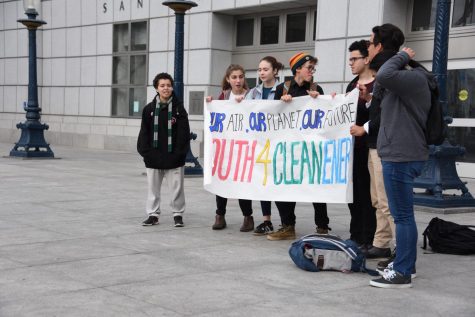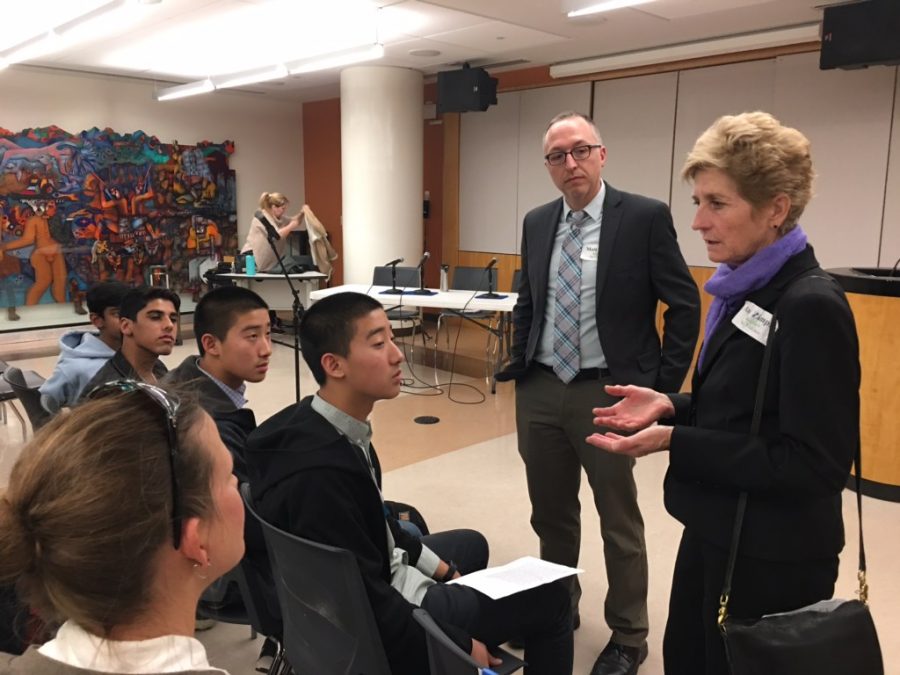Global Reset: Students fight Clean Power Plan repeal
Provided by Dr. Kate Schafer
Green Team members speak to EPA official safter the listening session held by the EPA on Feb. 28.
April 23, 2018
The words “Speaker 117” echo through the room as a teenager, the first speaker of the session, rises from her seat. All heads turn towards her as she slowly makes her way to the podium at the front of the room, the soft squeak of her shoes making the only sound in the room. Taking a last peek at her notes for a hint of reassurance, she takes a deep breath and begins to speak. “My name is Satchi. I’m a senior in high school, and I do not support the repeal of the Clean Power Plan.”
In light of the proposed repeal of the Clean Power Plan, upper school students from the Green Team and the Speech & Debate Team attended a special listening session held by the Environmental Protection Agency (EPA) in San Francisco on Feb. 28 in order to voice their opposition to the proposal. Seven students spoke in front of members of the EPA, highlighting various concerns regarding the repeal.
“The day coal runs out is not far off in the future. It is not a problem you can put off. It’s not just another burden you can pile on our shoulders. We will be the ones sending our children to school in face masks; we’ll be the ones with frequent asthma attacks; we’ll be the ones with poisoned water tanks; we’ll be the ones with no food,” one of the speakers and Green Team co-president Satchi Thockchom (12) said. “We’ll be the ones begging other countries for their technology, for their research, for their health care, for their help. You’ll be the ones remembered for trying to repeal this act. You’ll be the ones who created this future for us.”
The Clean Power Plan (CPP) is an Obama-era policy that mandates that individual states meet specific standards with respect to the reduction of their carbon dioxide emissions. First proposed by the EPA in 2014, it required that states submit a plan for emission reduction by September 2018 at the latest. Currently, the EPA under the Trump administration has begun to move forward with its repeal.
“If Hurricane Harvey and the California wildfires were wakeup calls to our nation that our fragile environment needs fixing, then the phone is still ringing. And a crucial policy that can answer the call is the Clean Power Plan. Because climate change intensifies natural disasters. In the Atlantic, more Carbon, warmer waters, rising sea levels gives any developing hurricane the vapor it needs to sustain superstorms,” one of the speakers Avi Gulati (10) said. “A World Weather Association study discovered that anthropogenic climate change made Hurricane Harvey rainfall 15% more intense and 3 times more likely to occur. Without strict regulations like this we can expect a hurricane of environmental turmoil.”
Students used studies such as the World Weather Association study to support their arguments with concrete scientific evidence.
Satchi, sophomores Jai Bahri, Anvi Banga, Avi, Alex Shing and Anthony Shing and freshman Akshay Manglik spoke about various negative implications of repealing the plan, from economy to emissions. The students are all members of the upper school Green Team and were accompanied by advisors Kate Schafer and Diana Moss.
“The EPA wanted to repeal the Clean Power Plan that affects the entire country and they were going on a nationwide tour and only stopping in four places so we were really lucky that one of the places was San Francisco, just an hour’s drive away, so we wanted to seize that opportunity,” Satchi said.
Students discussed the negative impacts of carbon emissions, citing recent natural disasters like the wine country wildfires, predicting negative economic consequences of the repeal and drawing on their own personal experiences.
“When I was younger, I lived in China for four years. The polluted air in Shanghai was terrible for my health and I had a breathing problem there. For many years, China ignored climate change and did not regulate their carbon emissions,” Alex said. “Now, However, China is doing even better than the United States regarding the adoption of renewable energy. China has currently pledged to invest 367 billion dollars in the renewable energy industry, an investment that will create 10 million jobs in this sector.”
The seven students were among hundreds of Californians who poured into the San Francisco Public Library to protest the repeal of the plan. Activities began with a rally in the morning and were followed by a listening session.

The listening session in San Francisco was not originally slated in the EPA’s activities — one session was planned for West Virginia, a state with a booming coal industry, but the outpouring of out-of-state support for the Clean Power Plan led the agency to hold an additional session in San Francisco, reflecting the environmentalist sentiment that has come to characterize the state, as well as sessions in Missouri and Wyoming.
California has long been a frontrunner in environmental policy and the reduction of carbon emissions. Governor Jerry Brown made a commitment last year to exceed the goals set by the CPP. California is now on track to produce 33 percent of its power from renewable sources by 2020 and 50 percent by 2030. The plan’s repeal would leave states like California and Hawaii, which has pledged to switch to 100% renewable energy by 2020, far ahead of many others in terms of its economic policy.
Green team members Anika Banga (12), Anvi and Sachi Bajaj (9) attended a climate change forum hosted by two California State Assembly representatives on Jan. 25. The main focus of the forum was the SB100 bill, which calls for California to use 100% clean energy by 2045.
“As minors, we often feel like we don’t have a voice because we can’t vote. But in recent years, I have learnt that we really can make an impact,” Green team co-president Anika said. “Political leaders want to hear from us and because it’s so rare for children under the age of 18 to attend meetings such as these, they really do listen to us.”
Californian goals match with those of the CPP as a whole, which centers around three tenets: increasing the generation efficiency of existing fossil fuel plants, substituting coal power with natural gas and substituting fossil fuels with renewable sources. The EPA aimed to reduce overall carbon dioxide emissions while also hoping to reduce the pollutants that contribute to smog and soot by 25 percent. It was also projected to be economically beneficial, saving the average family $85 per year in energy bills by 2030 and creating hundreds of thousands of jobs.
Under the Obama administration, the Clean Power Plan was the federal government’s response to the challenges put forward by the Paris Climate Accord, a way of showing that the United States was serious about its commitment to reducing carbon emissions.
Since his election, President Trump has long discussed both a repeal of the Clean Power Plan and a withdrawal from the Paris Climate Accord. In March of 2017, Trump signed an executive order asking Pruitt to begin repealing the plan. The following October, EPA head Scott Pruitt announced the beginning of its dismantling.
“I learned that the entire EPA is not just one big bad person, it’s comprised of a lot of different people, with a lot of different priorities so not just to be mad at the system but to work with it,” Satchi said.
The CPP has been swamped in legislative battles since its creation — when it first came into effect in 2016, it was immediately blocked by the United States Supreme Court. Since then, numerous other lawsuits have questioned its place in American policy.
Now, however, lawsuits against the repeal have sprung up as well, along with more grassroots, people-oriented movements such as the listening session. Students were able to not only present their ideas but also discuss their speeches with EPA representatives after the session, leaving them hopeful for the plan’s future.
This piece was originally published in the pages of the Winged Post on March 29, 2018.


















![“[Building nerf blasters] became this outlet of creativity for me that hasn't been matched by anything else. The process [of] making a build complete to your desire is such a painstakingly difficult process, but I've had to learn from [the skills needed from] soldering to proper painting. There's so many different options for everything, if you think about it, it exists. The best part is [that] if it doesn't exist, you can build it yourself," Ishaan Parate said.](https://harkeraquila.com/wp-content/uploads/2022/08/DSC_8149-900x604.jpg)




![“When I came into high school, I was ready to be a follower. But DECA was a game changer for me. It helped me overcome my fear of public speaking, and it's played such a major role in who I've become today. To be able to successfully lead a chapter of 150 students, an officer team and be one of the upperclassmen I once really admired is something I'm [really] proud of,” Anvitha Tummala ('21) said.](https://harkeraquila.com/wp-content/uploads/2021/07/Screen-Shot-2021-07-25-at-9.50.05-AM-900x594.png)







![“I think getting up in the morning and having a sense of purpose [is exciting]. I think without a certain amount of drive, life is kind of obsolete and mundane, and I think having that every single day is what makes each day unique and kind of makes life exciting,” Neymika Jain (12) said.](https://harkeraquila.com/wp-content/uploads/2017/06/Screen-Shot-2017-06-03-at-4.54.16-PM.png)








![“My slogan is ‘slow feet, don’t eat, and I’m hungry.’ You need to run fast to get where you are–you aren't going to get those championships if you aren't fast,” Angel Cervantes (12) said. “I want to do well in school on my tests and in track and win championships for my team. I live by that, [and] I can do that anywhere: in the classroom or on the field.”](https://harkeraquila.com/wp-content/uploads/2018/06/DSC5146-900x601.jpg)
![“[Volleyball has] taught me how to fall correctly, and another thing it taught is that you don’t have to be the best at something to be good at it. If you just hit the ball in a smart way, then it still scores points and you’re good at it. You could be a background player and still make a much bigger impact on the team than you would think,” Anya Gert (’20) said.](https://harkeraquila.com/wp-content/uploads/2020/06/AnnaGert_JinTuan_HoHPhotoEdited-600x900.jpeg)

![“I'm not nearly there yet, but [my confidence has] definitely been getting better since I was pretty shy and timid coming into Harker my freshman year. I know that there's a lot of people that are really confident in what they do, and I really admire them. Everyone's so driven and that has really pushed me to kind of try to find my own place in high school and be more confident,” Alyssa Huang (’20) said.](https://harkeraquila.com/wp-content/uploads/2020/06/AlyssaHuang_EmilyChen_HoHPhoto-900x749.jpeg)










